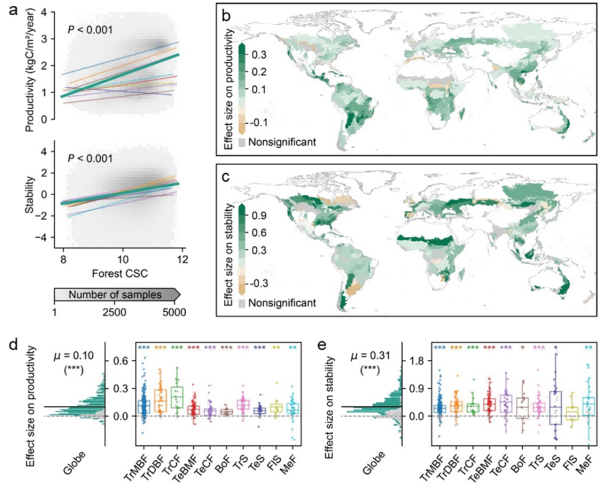The complexity of forest canopy structure is manifested by the occupation and distribution heterogeneity of canopy elements such as leaves and branches in three-dimensional space. It can change forest productivity and stability by regulating the allocation of light and water resources within the canopy, thereby affecting key functions such as carbon sequestration and conservation in forest ecosystems. Therefore, elucidating the relationship between the complexity of forest canopy structure and forest productivity and stability is crucial for studying forest ecosystem processes and formulating forest management policies. However, there is controversy over the existing research results at the scale of sample plots. The lack of complex distribution products of large-scale forest canopy structure is the main factor limiting the exploration of its relationship with forest productivity and stability.
The Su Yanjun research group of the Institute of Botany of the Chinese Academy of Sciences integrated airborne lidar data and GEDI spaceborne lidar data from 4000 forest samples around the world, described the global distribution pattern of forest canopy structure complexity, and analyzed the relationship between forest canopy structure complexity and forest productivity and stability. The results indicate that the complexity of canopy structure has a positive impact on forest productivity and stability in global forests, but the magnitude of the impact varies spatially among different forest ecological divisions. This variation is the result of a combination of biodiversity effects and resource availability. The above achievements provide a new perspective for resolving the controversies in existing scale research on sample plots. In addition, studies have shown that in non native forests, the complexity of forest canopy structure is lower than that in native forests, but it has a stronger positive promoting effect on productivity and stability, indicating that the management process of non native forests should pay attention to the complexity of canopy structure. This study found that combining tree species and age to enhance the complexity of forest canopy structure will help enhance the carbon sequestration and retention capacity of non native forests.
On May 15th, the relevant research results were published online in Science Advances. The research work has received support from the National Key R&D Program and the National Natural Science Foundation of China.
Paper link

The impact of the complexity of canopy structure on global forest productivity and stability




